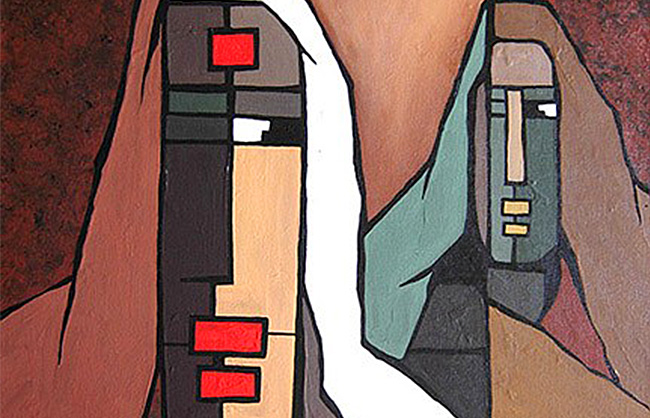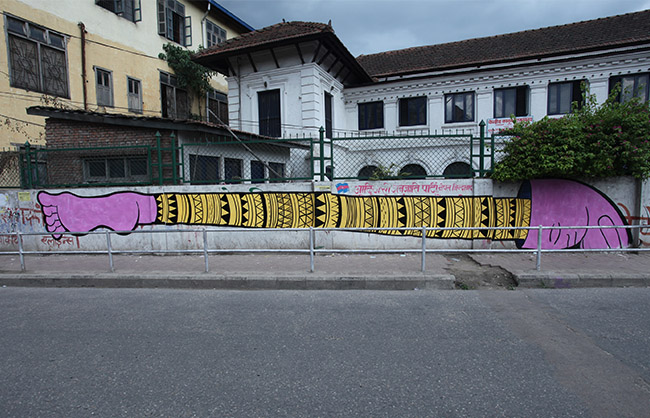Writing
Project Details
Title: On the avant-garde highway
Category: Writing
Date: 25 November 2015
Share:
In the current Nepali art scenario, installations, particularly video installations, are a form that is still perceived to be contemporary to the Western world, and thus fated to be bypassed. Regardless of the meaning and the purpose, the works of artists from abroad risk being perceived as a by-passer’s casual experimentation or a rather complex art form; at best, modern art.
But, in December 2009 at the Alliance Française in Kathmandu, a young French artist, Emma Ponsart, took a different approach. The event was named Visual poems: A Score for Experimenting your Perceptions, and was described to be ‘an original contemporary art exhibition in Kathmandu’. Rather than imposing large pieces of perplexing, unfamiliar canvasses, this event encouraged spectators to physically, visually and spiritually interact with the art-from — with one having to move across a candle-lit path, walk on grass, and through open spaces. The results were the distinct reactions of the viewers at the event, a form of avant-garde experimentation that has grown to a broader form with no hints of slowing down, and whose influence is yet to be amply realised.
Ponsart is now set to bring her next installation, titled Remanences: Worlds in Essence from Sunday, March 14 at the Kathmandu Contemporary Arts Centre.
And what an installation it shall be.
Ponsart is a video and installation artist from France. Twenty years ago, her father, a frequent trekker to the remoter parts of Nepal, had taken photographs from the visit. This artist, currently pursuing her Master’s in Fine Art at ESAG, the Ecole Supérieure d’Art de Grenoble, in France, came upon her father’s photographic archives. She discovered a sudden attachment to the land only on the basis of the pictures, and an emotional connection to Nepal though she had never been here. “When I found those pictures, I felt like I was in a dream. I had never before come to Nepal, but I felt that connection. I felt like I had already lived here,” Ponsart says, “And when I did come here, I was not surprised. It was like coming home.”
Her December works were the homecoming gift that she bestowed on the Nepali art scene. She showcased three video installations, all neatly-edited footage of happenings and things that we see daily, but fail to realise their importance. Ponsart’s titles — Morphose, Vision, and Extraction — posed questions to our relaxed perceptions of a sensitive world. The installations, part of the Visual Poems exhibition, was an introductory crowd-mover. Walking across a path lit with candles and incense, viewers reached a garden where they could watch three videos installed on grass (yes, grass). These soundless installations were like paintings in flux, dynamically changing, where each video held a symbolic meaning. Moving further through the installation, viewers reached an empty classroom with its doors slightly open and a number of chairs randomly placed facing a television set that broadcasted a loop of the video titled Throw-Through. This particular loop brought upon an idea of wandering through a space between inside and outside.
Further along the path lay the third and the most unique video projection, Reminiscence, where a screen blocked the route of the viewer to move further. Housed in a narrow hallway, the projection played out on the side walls, where the viewer had to enter the light, hence casting one’s own shadow on the screen. The projections, much like a surreal frenetic apparition, seemed to be continuously disappearing pictures of light and an eclipsed moon, where the shadow intervened like a dance performance of filigree. Being stylistically dissimilar, these installations asked the question of existentialism in a materialistic world.
Now, two months later, looking back at the artist’s work, her forthcoming event promises an unrivalled experience.
Though common now in the Western art world, will the people in Kathmandu be able to understand and react to these new video installations remains a question that needs to be answered. Historically, art was connected with aesthetic and beauty as a means of noble expression; then on, its classical sense was related more in terms of romance and beauty. Now the prospects have broadened to become more than just the elements of beauty. Art is now created in relevance to the place and time that one lives in. Ponsart’s installations are exactly these manifestations that challenge the classical ideas still prevailing in Nepal.
Inspired from modern masters, such as Merce Cunningham, John Cage and Marcel DuChamp, who questioned, elaborated and expanded beyond the classical understandings of art, Ponsart too brings forth a change in the forms of video-graphical experimentations.
Meanwhile, an installation at a well-known gallery for a considerable time has always been a hard task to accomplish for all artists in Kathmandu. Some seek resort in the form of Land Art for the same reason. Unlike paintings, installations are not status-bearing products that are produced every season. They are, instead, antonyms that oppose and abandon the idea that manufactures saleable commodities in favour of pure art. This very idea of manipulating art with the market’s demands of vendor art has somehow restricted the growth of installations in Kathmandu. But Ponsart attempts to go beyond these casual perceptions, and, more importantly, her art forms demand the involvement of its viewers to accomplish its purpose. The reactions, the surprises, the hesitation, are integral parts of her works, just as much as the artist’s own input in creating it. This very fact makes Ponsart’s art distinct in the contemporary Nepali art scenario.
Over the course of a six-month residency in partnership with the Alliance Française in Kathmandu, Ponsart’s next event is an experiment and reflection of the world today. With her father’s 20-year-old photo archives as a guide to the country, the artist experimented and wandered in her father’s trekking footsteps, using the old images as lyrical scores for her own work. Instead of recording images with a camera, she decided to record the perceptions of the journey in her memoirs. She recorded sounds and videos on her trip, depicting the immaterial nature of existence. Her poetic visions built on utopian situations tend to include the audience as the experimental auteur, hence transforming the audience’s relations and perceptions into possibilities and questions about a materialistic world. Casting old perceptions aside, the artist presents an alternative to enhance our ability in creating a universe of our own. For an art lover, missing this event would be missing an ode to the contemporary Nepali symphony of art.
Remanences: Worlds in Essence was installed at the Kathmandu Contemporary Arts Centre in Jhamsikel, Lalitpur, from March 14 to March 20.








